If you find yourself working as a teacher in the interior of South Korea and have yet to experience a summer here: get ready. A wall of heat and humidity unlike anything that you’ve ever experienced in your life is coming.
While you’ll likely have an A/C unit in your apartment (you DO have one right?) and hopefully some at work (private hagwons may, but public schools often do not), eventually you will have to step outside to head home, go grocery shopping, or meet your friends at the bar.
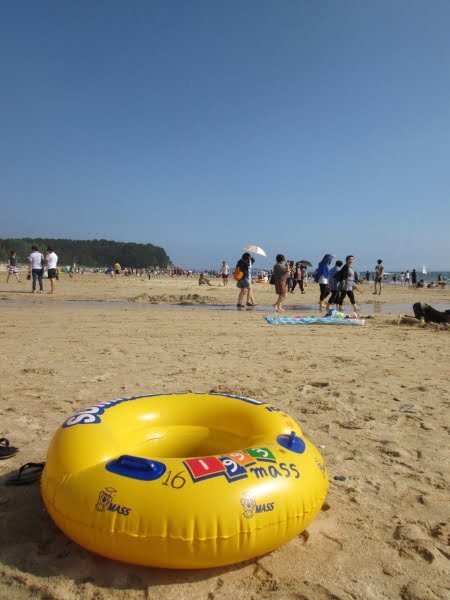
The soul-stealing muckiness will have you doing the unthinkable: cursing the sun and praying for a rainy day to cool things down (don’t laugh, because you will!) However, it isn’t all bad: on your weekends, South Korea’s robust transport network will allow you the opportunity to flee the furnace-like interior and get to the coast, where a variety of surprisingly awesome beaches await your overheated body.
While the most famous strips of sand in the country lie within the urban environment of Busan, or on the fairytale island of Jeju, the West Sea beaches of in the Boryeong area are considerably less crowded (by Korean standards), of which Daecheon Beach is the most popular.
For those not wanting to travel to the opposite end of the country to get in some time on a sun lounger, Daecheon is a tantalizing alternative. When I taught in South Korea in the Cheonan/Asan area in 2013, I went on a weekend adventure to this place to see what it was all about, and I was suitably impressed.
What follows is a guide of how to get there, what is worth doing, and sights that I found amusing and/or delightfully weird. Hope you find it useful!
Daecheon Beach Guide
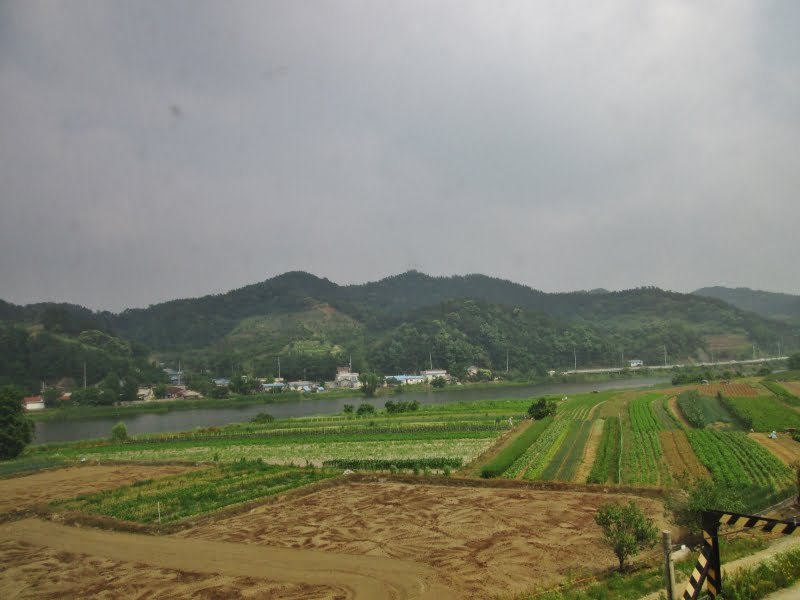

If you are coming down from Seoul on the KTX, you’ll have to switch to the ITX, which is slightly slower of foot at a pedestrian 180 km/h, but you’ll have a much better opportunity to witness countryside scenes like the ones pictured above, instead of having go by in a blur of green and blue.
As fun as the journey to get to Daecheon Beach was, it was time to get out there and explore everything this uniquely Korean beach town had to offer…
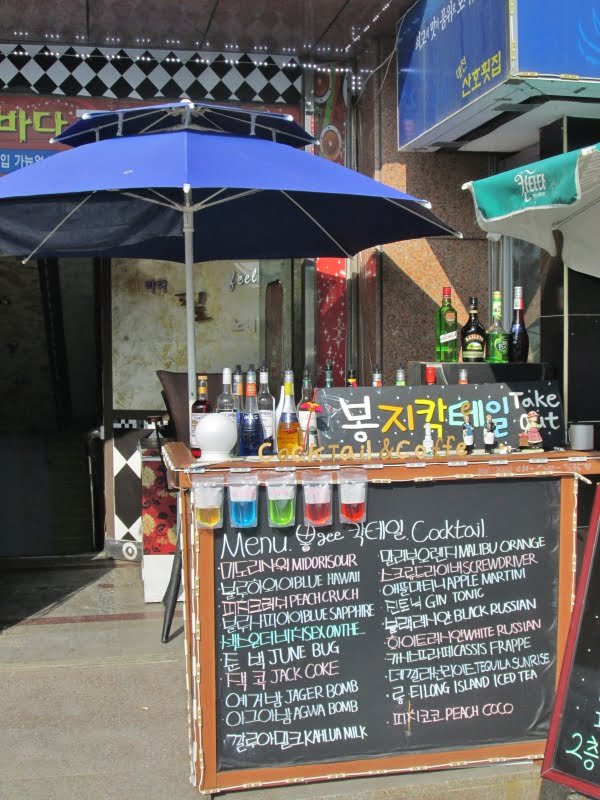
Korea is renowned for its drinking culture, and with numerous stands just like this, Daecheon Beach is no fortress of temperance either!
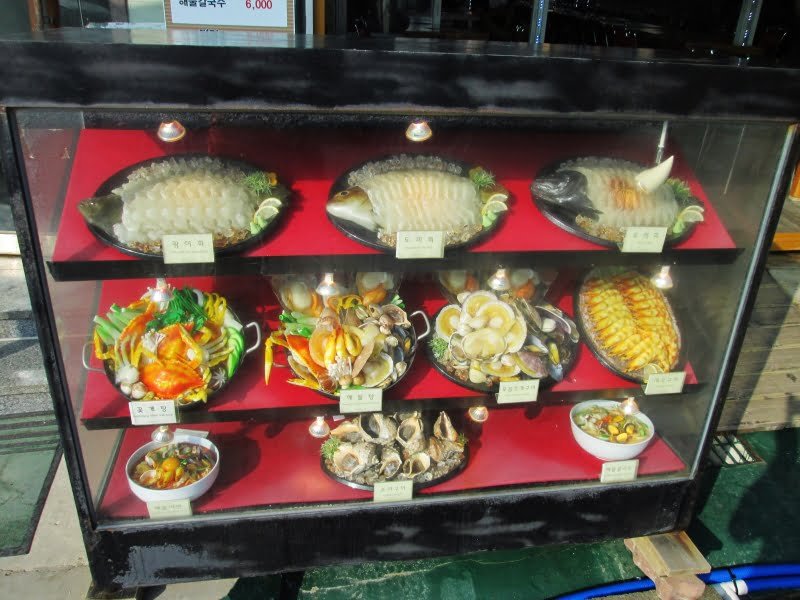
Being a marine nation where the ocean is never that far away, seafood can be easily found throughout much of Korea, but with the port of Boryeong being close by, there is a particular abundance of dishes from the sea along the main streets of this resort town.
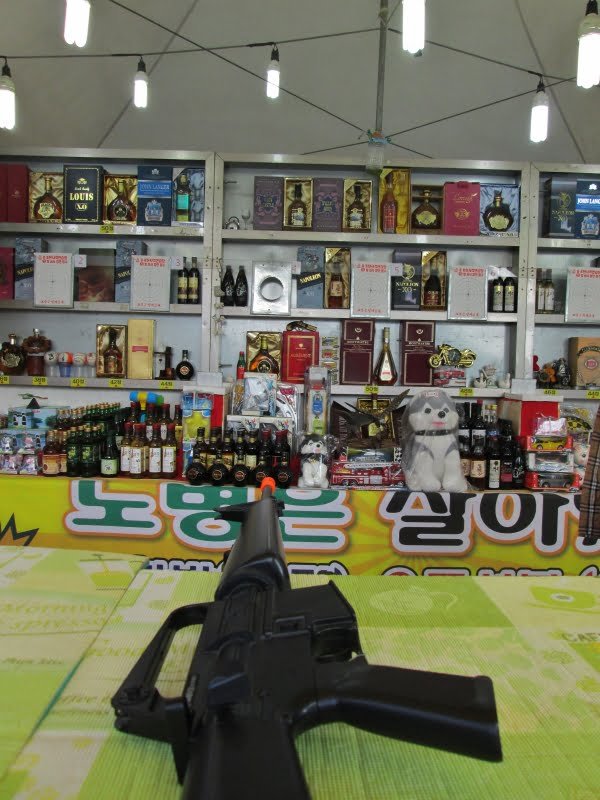
Being the official opening day for Daecheon Beach, a lively party atmosphere reigned through the town. This meant that midway games were available, and being the manly man that I am, I decided to put my shooting skills to the test.
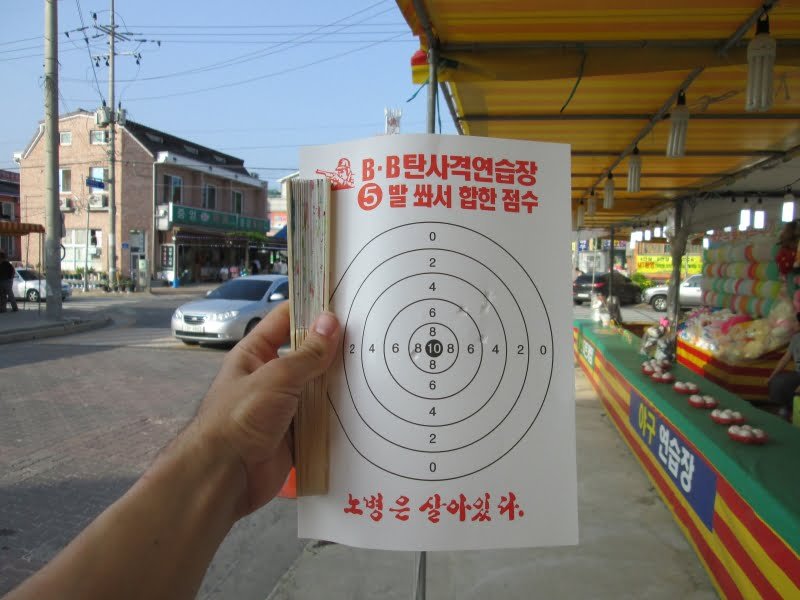
Apparently I need to work on my aim before this Ebola thing morphs into the zombie apocalypse, because I missed on all my attempts, hitting 2 sixes and a four (the guy manning the game felt sorry for me and nailed an 8 at point blank range so I could look better to my friends … gotta love the “saving face” culture here!
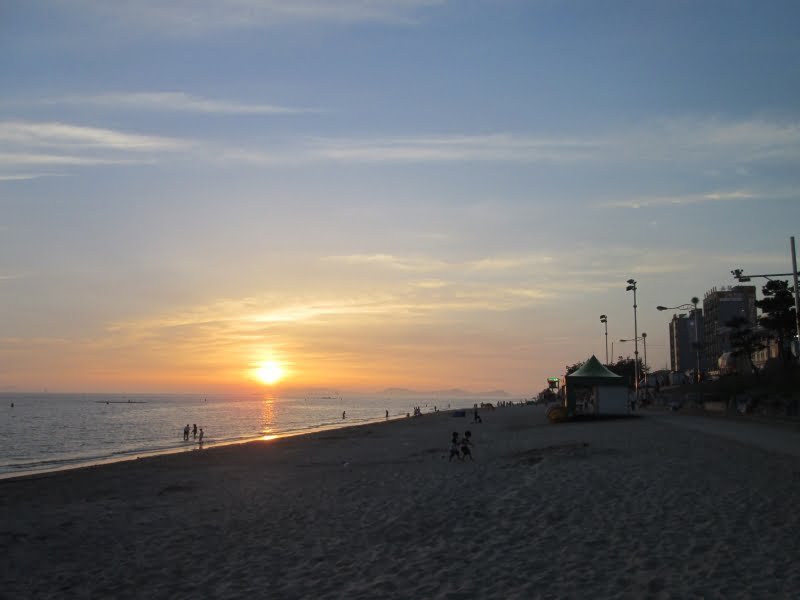
After a long day of exploring the beach and the surrounding town, a perfect end to the day with a sunset that would surely mark the start of what would be an excellent summer in this delightful beachside town in South Korea.
How to get to Daecheon Beach:
From Seoul – If you’re coming from the big city, taking the ITX from Seoul station all the way to Boryeong would be best if you don’t like the idea of transferring trains. If you’re pressed for time though, you can take the KTX to Cheonan-Asan, and then make the lengthy walk from the bullet train platform to the slower ITX (bear in mind you’ll have to buy a 2nd ticket here to continue onwards).
Also, the ITX shares the platform with Seoul subway Line 1, so ensure you are facing the proper track, lest you miss your train!
About the guest poster…
James Shannon is a freelance writer and social media specialist roaming the world in search of exciting experiences, be it through exotic cuisine, an amazing alpine hike, or through the acquisition of new skills and perspectives. His goal is set boots down on all seven continents by the time he is 40 years old, with #3 (South America) coming up in the New Year. You can follow his ongoing adventures in world travel, outdoor adventure, and life fulfillment on his blog, The Pursuit of Excitement, or via his social media accounts on Facebook or Twitter.
______________________________________________________________________________________________________________
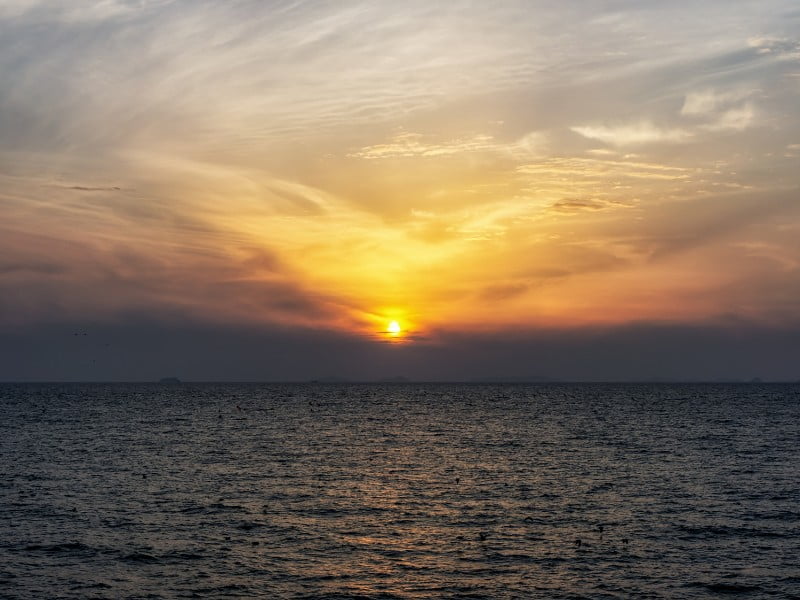
Daecheon Beach: History And Information For Visitors
Daecheon Beach, located on South Korea’s west coast, has a history intertwined with the local culture and development of Boryeong City. The beach became widely known in the late 20th century as a popular destination for both locals and tourists, thanks to its expansive sandy shores and scenic views. It’s also famous for the Boryeong Mud Festival, an annual event that attracts millions of visitors from around the world.
- Mud Festival Origins: The Boryeong Mud Festival began in 1998 as a marketing initiative for the region’s mineral-rich mud, known for its cosmetic benefits. Over the years, it has grown into a major international event, making Daecheon Beach a key tourist attraction in South Korea.
What to Expect at Daecheon Beach
Daecheon Beach is the largest beach on Korea’s west coast, stretching over 3.5 kilometers. The beach is known for its soft, white sand, which is actually made up of tiny shells that are gentle on the feet. The waters here are shallow and calm, making it an ideal spot for swimming, especially for families with children. The beachfront is lined with a variety of cafes, restaurants, and shops, offering everything from seafood delicacies to souvenirs.
- Beach Activities: Beyond swimming and sunbathing, visitors can enjoy activities like jet skiing, banana boating, and beach volleyball. There’s also a boardwalk that’s perfect for a leisurely stroll along the shore.
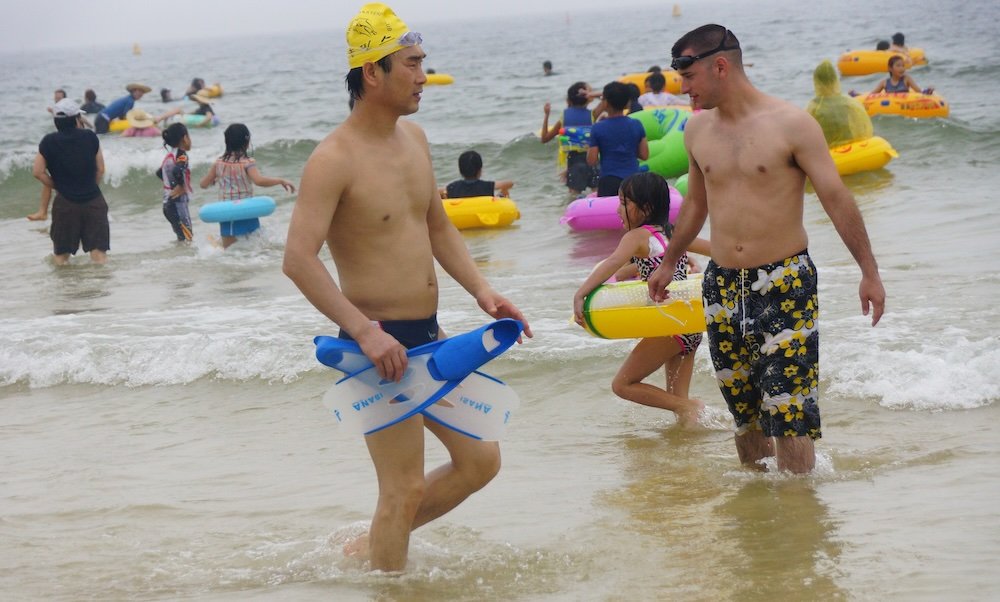
Unique Features of Daecheon Beach
What sets Daecheon Beach apart from other beaches in South Korea is its unique combination of natural beauty and vibrant cultural events. The Boryeong Mud Festival is undoubtedly the highlight, offering visitors the chance to engage in mud wrestling, mud sliding, and even a mud marathon. The festival has helped put Daecheon on the map, but the beach’s serene beauty and relaxed atmosphere are what keep visitors coming back year after year.
- Scenic Sunsets: One of the most breathtaking experiences at Daecheon Beach is watching the sunset over the Yellow Sea. The expansive horizon and reflective waters create a stunning backdrop that’s perfect for photography or simply soaking in the moment.
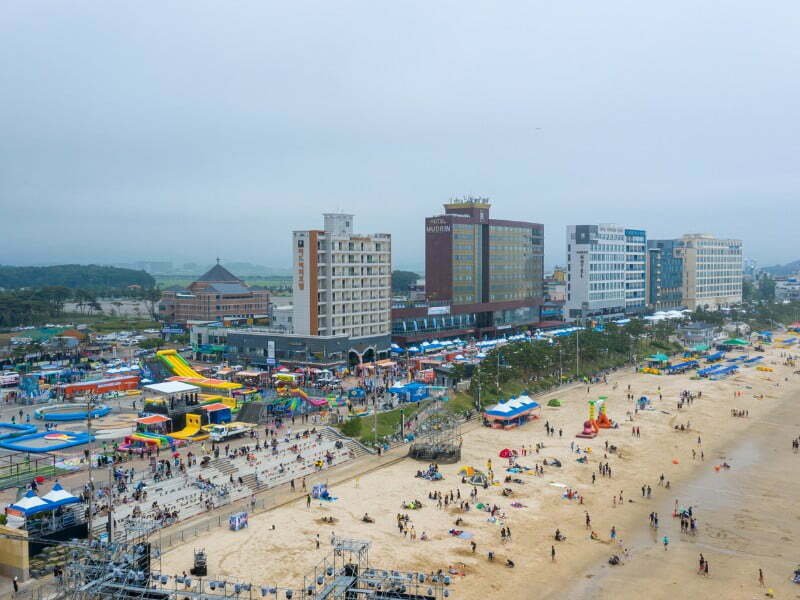
How To Visit Daecheon Beach: Transportation Guide
By Train: A Scenic Route
One of the most convenient ways to reach Daecheon Beach is by train. Take the KTX or Mugunghwa trains from Seoul Station to Daecheon Station. The journey on the KTX takes about two hours, offering a comfortable and scenic ride through the Korean countryside. Once you arrive at Daecheon Station, the beach is just a short taxi or bus ride away.
- Tip: If you’re traveling during peak times, especially around the Boryeong Mud Festival, it’s advisable to book your train tickets in advance to ensure availability.
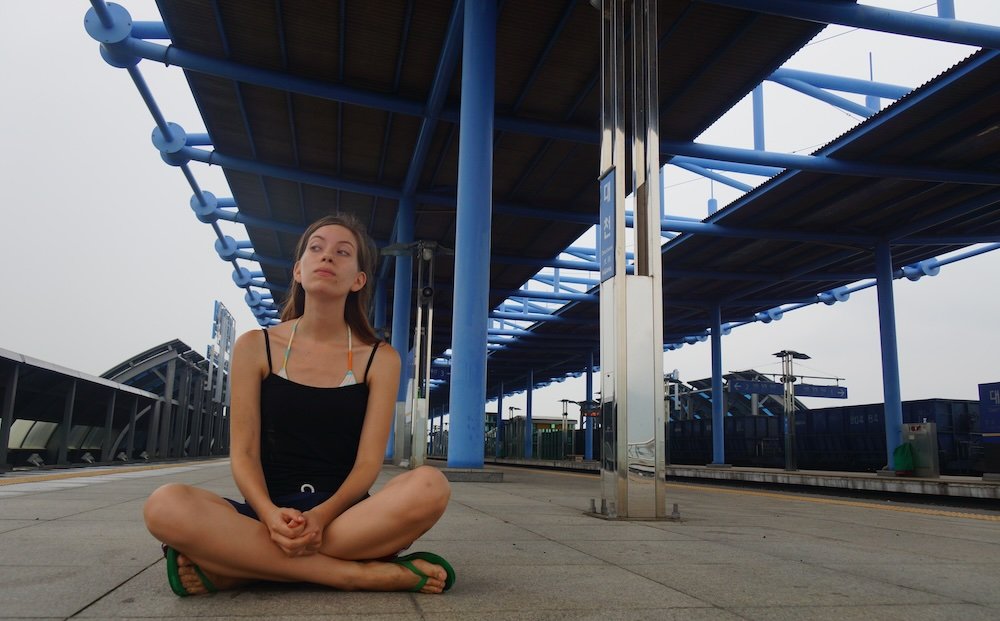
By Train: From Various Cities
Traveling by train to Daecheon Beach is straightforward, with options available from multiple cities. From Busan, you can take the KTX to Daejeon Station, then transfer to a Mugunghwa or Saemaeul train to Daecheon Station. This journey takes about four hours, combining the speed of the KTX with the scenic route of the Mugunghwa train.
- Alternative Route: Another option from Busan is to take a direct Mugunghwa train, which offers a slower but more scenic route through the countryside, taking around five hours.
By Bus: Direct and Budget-Friendly
Another popular option is taking an express bus from Seoul’s Central City Bus Terminal to Boryeong Bus Terminal. The bus ride takes approximately two and a half hours. From the bus terminal, local buses or taxis can take you directly to the beach. This option is often cheaper than the train and offers a direct route without transfers.
- Convenience: Buses run frequently, making this a flexible option for travelers who prefer a direct, budget-friendly route.
By Bus: Direct and Convenient Options
Express buses connect Daecheon Beach to major cities across South Korea, making it easy for travelers from Busan, Daegu, or Gwangju to visit. From Busan, express buses run frequently and take around four to five hours to reach Boryeong Bus Terminal. From there, it’s a short local bus or taxi ride to the beach.
- Flexible Travel: Buses are a great option for those who prefer direct travel with minimal transfers. They’re also budget-friendly, offering a comfortable and affordable way to reach the beach.
By Car: Flexibility and Exploration
For those who prefer flexibility, driving to Daecheon Beach is an excellent choice. The drive from Seoul to Daecheon takes about two and a half hours via the Seohaean Expressway. Having your own vehicle allows you to explore the surrounding areas at your own pace, including nearby attractions like the Seongjusan National Forest and Mud Theme Park.
- Parking: Ample parking is available near the beach, especially outside of festival times. Just keep in mind that traffic can get heavy during peak seasons.
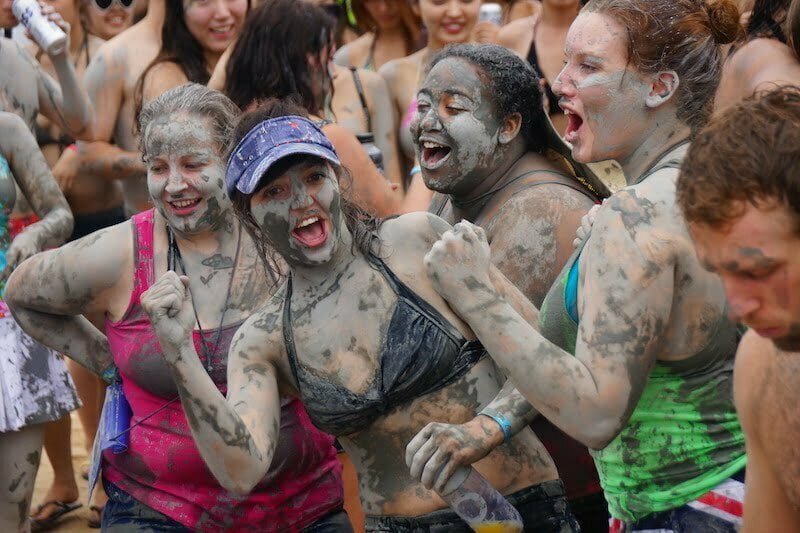
Boryeong Mud Festival: Information For Visitors
What is the Boryeong Mud Festival?
The Boryeong Mud Festival, held annually in Boryeong, South Korea, is a one-of-a-kind event that draws visitors from all over the world. Initially started in 1998 to promote the benefits of the local mud’s mineral-rich properties, it has since evolved into a massive celebration of fun and wellness. The festival typically takes place in July and lasts for about two weeks, transforming Daecheon Beach into a lively playground filled with mud-related activities.
- History: The festival began as a marketing campaign to promote Boryeong’s mud cosmetics. Over the years, it has grown into one of Korea’s most famous and internationally recognized events, attracting millions of visitors.
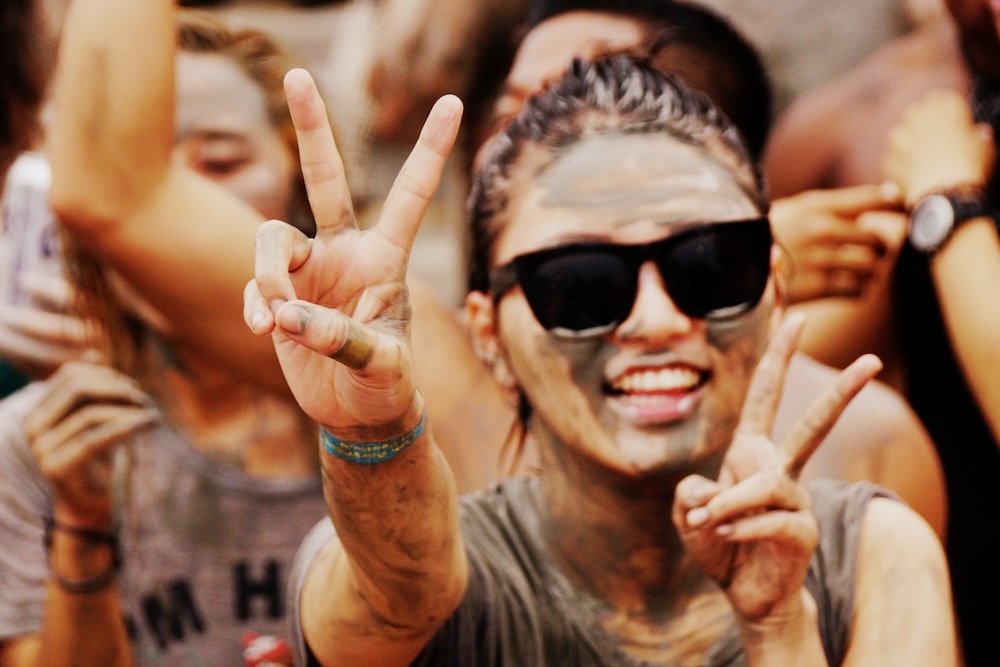
Activities and Highlights
The festival offers a wide range of activities that cater to both thrill-seekers and those looking for a unique wellness experience. The main attraction is, of course, the mud itself, which is packed with minerals like bentonite that are believed to be great for the skin. Visitors can engage in mud wrestling, mud sliding, and even mud marathons. There’s also a mud prison, mud baths, and mud body painting, providing endless entertainment.
- Mud Wrestling and Sliding: Dive into the giant mud pool for some friendly competition or take a thrilling slide down a mud-covered hill. It’s messy, fun, and absolutely unforgettable.
- Mud Baths and Spas: For those who prefer a more relaxing experience, the festival also offers mud baths and mud massages, allowing you to unwind while reaping the benefits of the mineral-rich mud.
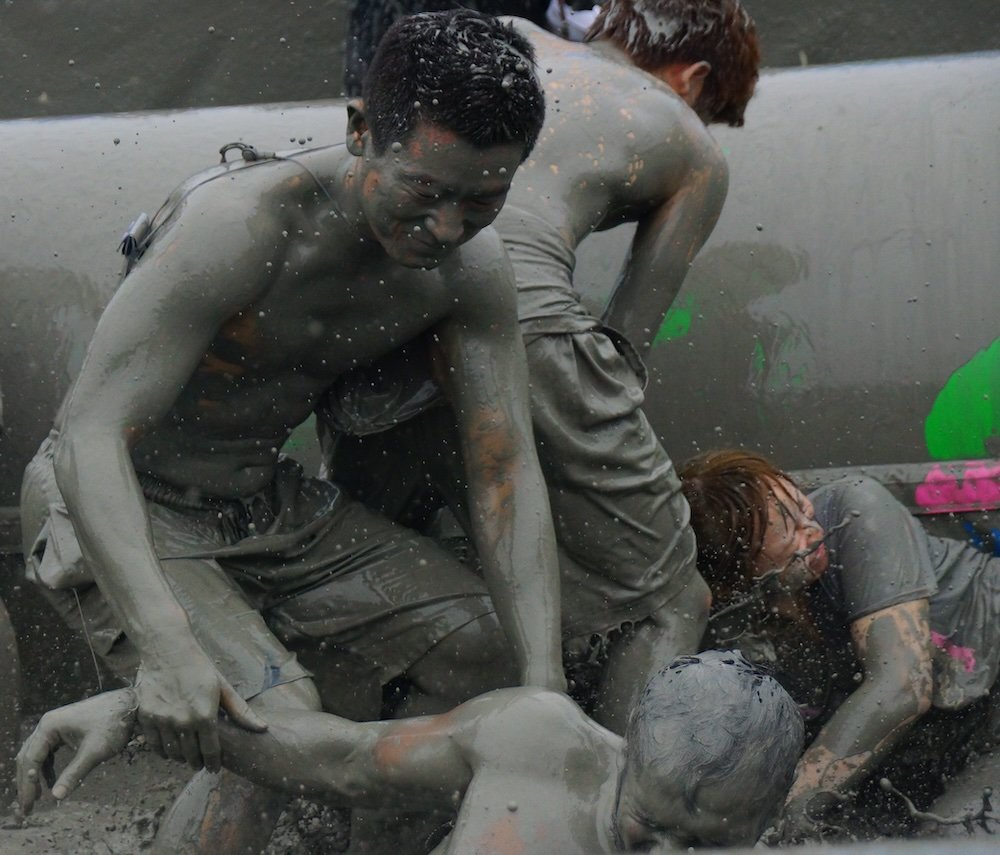
Entertainment and Events
In addition to the mud-based activities, the festival hosts a variety of cultural performances, live music, and fireworks displays. There are also traditional Korean games, K-pop concerts, and a vibrant street parade, ensuring that there’s something for everyone. The atmosphere is lively and inclusive, with people from all walks of life coming together to celebrate.
- K-Pop Concerts: The festival often features performances by popular K-pop artists, adding to the excitement and drawing in music fans from around the globe.
- Fireworks: The night sky over Daecheon Beach lights up with stunning fireworks displays, providing a perfect end to a day of mud-filled fun.
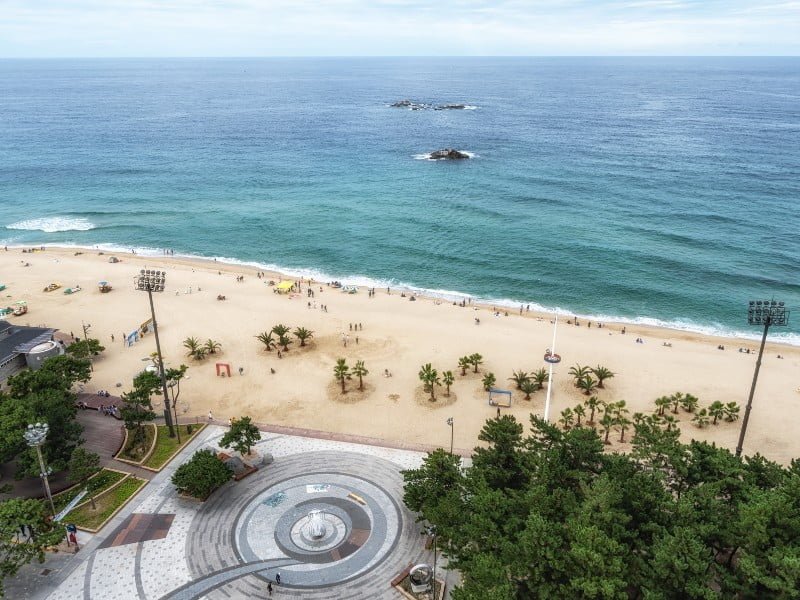
Planning The Perfect Daecheon Beach Weekend
Daecheon is one of those places that feels made for a teacher’s emergency escape. It’s close enough to hit for a spontaneous weekend, but far enough that, once you’re there, you feel like you’ve genuinely “left your life” for a couple of days.
Think of it as the middle ground between a full Busan or Jeju mission and an easy coastal getaway you can pull off with one backpack and a half-charged phone.
Who Daecheon Beach Is Perfect For
If you’re trying to decide whether to put Daecheon on your Korea beach rotation, this quick comparison helps:
| Beach | Vibe | Best For | From Seoul (approx.) |
|---|---|---|---|
| Daecheon | Casual, festival, teacher-y | Weekends, mud festival, easy seafood | 2–2.5 hrs |
| Haeundae (Busan) | Big city, buzzy nightlife | Longer trips, city + beach combo | 2.5–3.5 hrs |
| Gwangalli | Night views, cafés, locals | Date nights, evening walks, cafes | 2.5–3.5 hrs |
| Eurwangni | Quick airport/beach fix | Pre/post-flight, ultra-short trips | 1–1.5 hrs |
| Sokcho / East | Scenic, mountains + sea | Hiking + beach combo weekends | 2.5–3.5 hrs |
If you’re teaching in the interior (Cheonan, Daejeon, etc.), Daecheon is the sweet spot: minimal transfers, lots of cheap motels, and a very forgiving “no one cares if you’re covered in mud and eating ramyeon on the sidewalk at 1 a.m.” kind of energy.
2–3 Day Itineraries: Turn Heat And Humidity Into A Beach Break
Classic 2-Day “Teacher Escape” (Fri Night – Sun)
This is the move if you finish work on Friday, toss some clothes in a backpack, and just need to see the sea.
Friday Night: Escape The Interior
- Finish classes, inhale a kimbap, and grab the first ITX or express bus toward Boryeong/Daecheon.
- Aim to arrive at the beach around 9–11 p.m. – late enough that the air has cooled, early enough to still find food.
- Check into a yeogwan or motel near the main strip. Don’t overthink it: somewhere clean, aircon working, and ideally a convenience store within stumbling distance.
- Grab late-night chimaek (fried chicken + beer) or grilled clams right on the strip, then go for a barefoot walk on the sand to remind yourself that you’re not in a classroom anymore.
Saturday: Full Beach Day
Morning
- Hit the beach early before the parasols multiply. The West Sea is shallow and calm here, so it’s great for just floating with a rented tube.
- Rent a tube or inflatable from the stands lining the sand. They’ll often keep your valuables behind the counter if you ask nicely.
Afternoon
- Lunch at a seafood joint on the main road: think sashimi platters, grilled shellfish, spicy seafood jjigae.
- Grab an iced coffee and hide from the midday sun in a café or back in your room for a power nap.
- Late afternoon is perfect for another swim or walk once the UV index chills out a bit.
Evening
- Wander the midway-style game streets: BB gun ranges, ring toss, and random claw machines full of questionable prizes.
- Finish with sunset beers on the sand – the west coast sunsets over the Yellow Sea are genuinely beautiful, even after you’ve seen a few.
Sunday: Slow Roll Back To Reality
- Sleep in, pack up, stash your bag at your accommodation, and squeeze in one last beach walk or quick dip.
- Grab a simple brunch: kimbap, ramyeon, or a basic Korean diner set menu.
- Head back in the early afternoon so you’re not arriving home at midnight with ungraded worksheets staring at you from the desk.
Long 3-Day Trip: Beach, Mud, And A Bit Of Nature
If you’ve got a long weekend or can sneak a Friday/Monday off, you can pad things out nicely.
Day 1: Arrival + First Beach Session
Same as the classic Friday plan: travel, check-in, food, seaside walk. No need to complicate a good thing.
Day 2: Daecheon Beach + Mud Activities
Even outside the big summer festival, you’ll still find mud-themed fun in Boryeong, including a mud experience center and mud-based products that came out of the same boom that created the famous Boryeong Mud Festival.
- Spend the morning on the sand, rent a parasol, rotate between sea and shade.
- In the afternoon, check out mud-themed attractions or pick up mud cosmetics that Koreans actually use – face masks, soaps, and lotions made from the local mineral-rich mud.
- Evening: go for a proper sit-down seafood feast, then hit a noraebang (karaoke) with friends. Few things scream “Korea summer” like belting out power ballads after a day on the beach.
Day 3: Forest Or Countryside Detour
If you’re feeling beached-out, give your skin a break and head inland.
- Seongjusan Recreational Forest in nearby Boryeong has hiking trails, picnic areas, and, in season, wildflowers and cherry blossoms. It’s a proper “oxygen hit” after city life and a nice contrast to the coast.
- Pack simple picnic food, walk a trail for a few hours, then roll back down to Daecheon in time for a last coffee or ice cream before your train or bus.
Where To Stay Around Daecheon Beach
The good news: Daecheon is set up for crowds. That means lots of places to sleep at various price points. Especially if you’re not visiting on peak mud festival weekends.
Main Areas To Base Yourself
1. Beachfront Strip
- Right on or just behind the main road facing the sea.
- Think brightly lit motels, pensions, and family-run inns.
- Super convenient for stumbling home at night, but can be noisy during festivals or summer Saturdays.
2. Backstreets A Few Blocks Inland
- Same types of accommodation but usually a bit cheaper.
- Quieter at night and still an easy 5–10 minute walk to the sand.
- Great if you’re not fussed about a sea view and would rather save won for seafood and cocktails.
3. Boryeong City
- A taxi ride away from the beach, but rooms are often cheaper, especially in peak festival season.
- More “normal life” vibe: local restaurants, cafés, and fewer tourists.
- Good option if you arrive late, stay longer, or don’t mind a short commute each day.
Typical Price Ranges And What You Get
Rough ballpark for a summer weekend (non-festival):
| Budget Tier | Nightly Range (per room) | Location | What You Get | Best For |
|---|---|---|---|---|
| Budget | 40,000–70,000 KRW | Backstreets/city | Basic yeogwan/motel, A/C, TV, often PC in room | Teachers, solo travelers, duos |
| Midrange | 70,000–130,000 KRW | Beachfront/backstreets | Nicer motels/pensions, bigger rooms, maybe sea glimpse | Couples, small groups |
| Splashy | 130,000+ KRW | Beachfront | Newer hotels, sea views, better bedding, amenities | Mud festival trips, special weekends |
During the Boryeong Mud Festival, expect those numbers to jump significantly and book as early as you can – this thing pulls both locals and international visitors in serious numbers.
Eating And Drinking At Daecheon: What To Actually Order
One of the joys of a Korean beach town is that you can pretty much walk in any direction and eventually hit food.
Essential Beach Dishes
You’ll see a lot of similar menus along the main drag, but these are the staples worth prioritizing:
- Grilled shellfish (jogae gui): Clams, scallops, and assorted shellfish cooked right in front of you over coals. Usually served with butter, cheese, and a bit of drama.
- Raw fish (hoe): Thinly sliced sashimi-style fish served with gochujang-based dipping sauce and lettuce to wrap it all in.
- Spicy seafood stew (haemul jjigae): A bubbling pot packed with clams, shrimp, squid, veggies, and tofu. Amazing on a breezy evening.
- Fried chicken + beer (chimaek): Never a bad idea, especially if you’re eating casually on plastic chairs near the sand.
- Street snacks: Tornado potatoes, hotteok (sweet pancakes), skewers, and the usual Korean festival suspects when things are busy.
How Ordering Usually Works
- Many places have set menus for two or more people – don’t be surprised if you’re “strongly encouraged” to order at least one set dish.
- Sharing is normal: order a couple of mains for the table and everyone digs in.
- Side dishes (banchan) are endless and refilled on request – just politely flag someone down and say “yeogi-yo.”
What To Do Beyond Sitting On The Sand
Water And Beach Activities
On a busy summer day, Daecheon feels like one big playground:
- Tube rentals and inflatables: Almost mandatory. They keep you afloat in the shallows and doubles as a seat when you’re chatting in the water.
- Jet skis and banana boats: Look for signs along the beach – prices vary, so it’s worth glancing at a couple of booths.
- SUP or kayak rentals (seasonal): In calmer conditions, you can sometimes find stand-up paddleboards or small kayaks to take out.
The West Sea has big tidal swings, so the shoreline can retreat a long way out at low tide. It’s cool for photos and mud-flat wandering, but keep an eye on water depth if you’re not a confident swimmer.
Mud, Bikes, And Theme Park Energy
The mud isn’t just a once-a-year thing. Boryeong has leaned into its mineral-rich mud with year-round experiences, including a Mud Theme Park and mud-based activities where you can slide, soak, and smear to your heart’s content without needing the full festival chaos.
You’ll also find:
- Boardwalk strolls: Ideal in the cooler hours – grab an ice cream or iced latte and people-watch.
- Rental bikes or tandem bikes (seasonal): A fun way to cruise the strip and explore a bit further without relying on buses or taxis.
Forest And Hill Escapes
If the humidity and crowds get to you, heading up into the hills is an easy way to reset.
Seongjusan Recreational Forest near Boryeong offers marked trails, picnic spots, and, in season, cherry blossoms and wildflowers. The hike to the observatory isn’t extreme, but it’s enough to feel like you’ve earned your post-hike seafood.
Budgeting Your Daecheon Weekend
To keep expectations realistic (and avoid that “how did I blow that much on 48 hours?” moment), here’s a rough per-person guide for a 2-night summer weekend from Seoul, sharing a room with one friend.
| Category | Shoestring | Comfortable | Treat-Yourself |
|---|---|---|---|
| Transport (rt) | 25,000–35,000 KRW (bus) | 35,000–50,000 KRW (mix of KTX/ITX) | 50,000+ KRW (KTX + taxis) |
| Accommodation | 40,000–60,000 KRW per night (split) | 70,000–100,000 KRW per night (split) | 120,000+ KRW per night |
| Food & Drinks | 20,000–30,000 KRW per day | 30,000–50,000 KRW per day | 50,000+ KRW per day |
| Extras (games, rides, mud stuff) | 10,000–20,000 KRW | 20,000–40,000 KRW | 40,000+ KRW |
If you’re living on a teacher salary and don’t go wild at the bars, you can absolutely do a solid weekend under 150,000–200,000 KRW all-in. Go heavier on street food, convenience-store terrace beers, and midrange motels, and you’re golden.
Practical Tips And Common Mistakes To Avoid
What To Pack For A Summer Daecheon Run
- Light, breathable clothes: Korea’s summer humidity is no joke.
- Two swimsuits: One to wear, one to dry while you’re back in your room.
- Flip flops and one pair of sturdier sandals: Sand + random puddles + festival mud = ruined sneakers.
- A proper sunblock and maybe a hat you don’t mind ruining.
- A cheap tote or waterproof pouch for your phone, T-money card, and a bit of cash.
- If you’re planning to embrace the mud: an old T-shirt and shorts you’re not emotionally attached to.
Mud Festival–Specific Survival Tips
If you’re timing your visit with the Boryeong Mud Festival in July:
- Book accommodation absurdly early. Weeks or months, not days.
- Expect crowds, loud music, and prices to match the demand.
- Don’t bring anything into the mud zone that you’d cry about losing.
- Plan one “easy” day where you do something low-key – forest walk, café crawl, or just a slow beach afternoon – to recover.
Teacher-Specific Advice
If you’re living inland and relying on public transport:
- Always check the return schedule before you crack your first beach beer. Last buses and trains can be earlier than you think, especially on Sundays.
- Have backup routes: sometimes an indirect connection (via Daejeon, Cheonan, or another hub) gets you home when the direct one is sold out.
- Keep your Monday class schedule in mind. Maybe don’t plan your biggest mud wrestling session the night before you teach kindergarten phonics.
Why Daecheon Is Worth Keeping On Your Korea Shortlist
Daecheon isn’t the most glamorous beach in the country. It doesn’t have Jeju’s volcanic drama or Busan’s city skyline. But that’s exactly why it works so well as a weekend base.
It’s easy. It’s fun. It’s unapologetically a little tacky in spots, and very Korean in the best possible way: seafood feasts, convenience-store terrace drinks, garish neon hotel signs, and kids shrieking with laughter in the shallows.
If you’re sweating through another inland summer, staring longingly at your wall fan, Daecheon Beach is your reminder that you’re only a couple of hours away from sand, sea, and a sunset that makes all the classroom chaos feel just a little bit lighter.
Essential Questions About Visiting Daecheon Beach & Boryeong Mud Festival: Practical Answers & Local Tips
Is Daecheon Beach worth visiting if I’m already planning trips to Busan or Jeju?
Yes. Daecheon Beach has a totally different vibe from Busan and Jeju, and it really shines as an easy, low-stress weekend escape. Busan feels like a big city with a beach attached, and Jeju is more of a full-on “fly down and explore for days” kind of destination. Daecheon, on the other hand, is perfect when you just want to throw a change of clothes in a backpack, jump on a train or bus, and be on the sand a couple of hours later. It’s more compact, very Korean in the best ways (garish neon, seafood feasts, festival games), and when the Boryeong Mud Festival is on, it turns into one of the wildest summer parties in the country.
When is the best time of year to visit Daecheon Beach and the Boryeong Mud Festival?
Generally, the sweet spot for Daecheon Beach is late June to early September, when sea temperatures are warm enough that you actually want to be in the water, not just looking at it. Across South Korea, the sea is usually pleasant for swimming from June through September, with July and August at their warmest. The Boryeong Mud Festival typically runs for about two weeks in mid-to-late July at Daecheon Beach, with exact dates changing each year, so it’s worth checking the official festival website or the Boryeong city tourism page before you book. If you want good weather but fewer crowds, aim for late June or early September outside the main festival weeks.
How many days should I spend at Daecheon Beach on my first visit?
It depends. If you’re living in Korea and coming down from Seoul or an inland city, a 2-day weekend (Friday night to Sunday) is enough to swim, wander the midway, eat your fill of seafood, and reset your brain before Monday. If you’re timing your trip with the Mud Festival or want to add a forest day in Seongjusan Recreational Forest, stretching it to 3 days feels more relaxed and gives you space for at least one slower day. International visitors doing a broader Korea trip can fold Daecheon into a one- or two-night beach stop between city sightseeing days in Seoul or Daejeon without it feeling rushed.
Can I visit Daecheon Beach as a day trip from Seoul, or is that too rushed?
Technically, you can do it as a day trip, but I wouldn’t recommend it unless you’re really short on time. From Seoul, you’re looking at roughly 2–2.5 hours each way by either train (with a transfer) or express bus, plus local transit from the station or terminal to the beach. That means you’ll spend a good chunk of your “beach day” in transit. If it’s your only chance to see the West Sea, a day trip can still be fun: arrive mid-morning, rent a tube, linger for sunset, then head back. But if you can swing even one night, the whole experience feels less like a commute and more like a proper escape.
What’s the easiest way to get to Daecheon Beach from Seoul (train vs bus)?
Absolutely, you’ve got options. From Seoul, many people find the express bus easiest: you depart from Central City/Express Bus Terminal and ride about 2–2.5 hours to Boryeong’s Daecheon Bus Terminal, then hop on a short local bus or taxi to the beach. If you prefer trains, you can take KTX or ITX from Seoul Station toward Cheonan-Asan or other transfer hubs, then switch to a slower Mugunghwa/ITX line to Daecheon Station; total journey time is usually in the 2–2.5 hour range before the short hop to the coast. My rule of thumb: take the bus if you want simple, one-seat travel; pick the train if you value a bit more legroom and countryside views.
Do I need to book accommodation at Daecheon Beach in advance, especially for the Mud Festival?
Yes. On normal summer weekends you can sometimes wing it and wander the backstreets until you find a vacant yeogwan or motel, especially if you’re not picky about sea views. But during the Boryeong Mud Festival, rooms sell out fast and prices jump across both Daecheon Beach and Boryeong city. For festival dates, treat it like booking for a major event: reserve weeks or even a couple of months in advance if you want something close to the sand or a specific room type. Outside festival time and big holidays, I still like to book at least the first night so I’m not dragging luggage around in the heat.
Is Daecheon Beach safe for solo travelers and at night?
Mostly, yes. South Korea in general has a low crime rate and is often ranked among the safer countries in the world for visitors, especially when it comes to violent crime. Daecheon is very much a domestic vacation spot, so you’ll be surrounded by families, couples, and groups of friends rather than a sketchy party crowd. That said, basic big-crowd rules still apply during festival season and busy weekends: keep an eye on your phone and wallet, don’t leave valuables unattended on the beach, and pace your drinking so the late-night walk back to your motel stays uneventful.
Is Daecheon Beach a good choice for families with kids?
Absolutely. The beach has a gentle slope and generally shallow water near the shore, which makes it less intimidating for kids and weak swimmers than some steeper beaches. In high season, lifeguards and floating safety lines are usually in place along the main swimming zones, similar to other major Korean beaches. TThere are also lots of family-friendly distractions right off the sand: arcades, midway games, rental tubes, and plenty of casual restaurants where noisy, sandy kids are totally normal. If you’re visiting during the Mud Festival, look for family-oriented mud zones and quieter time slots earlier in the day.
What are the beach and water conditions like at Daecheon (tides, swimming, lifeguards)?
The West Sea is famous for its big tidal swings, and Daecheon is no exception, so don’t be surprised if the water seems to retreat a long way at low tide. The upside is a wide, hard-packed stretch of sand that’s great for walking and playing. In summer, the water temperature around Korea’s coasts is generally pleasant from June through September, with July and August being the warmest months for swimming. During peak season, expect designated swimming areas with lifeguards on duty, floating ropes, and plenty of rented tubes bobbing around. Just pay attention to posted signs, flags, and announcements—they’ll close swimming zones if conditions are unsafe.
How much should I budget for a typical summer weekend at Daecheon Beach?
Roughly speaking, if you’re sharing a room, a “normal” summer weekend from Seoul can land in the 150,000–250,000 KRW range per person, depending on how you travel and how hard you go on food and drinks. Buses are usually the cheapest way in and out; KTX + taxis bump things up. Accommodation ranges from simple motels in the backstreets to nicer beachfront spots, and seafood feasts can be either modest or blowout affairs depending on what you order. Mud Festival weekends will inflate all of those numbers, so if you’re on a teacher budget, avoid the peak days or lean heavily on street food, convenience-store beers, and cheaper yeogwan-style rooms.
What should I pack for a hot and humid Daecheon Beach weekend or the Mud Festival?
Brutal humidity is part of the deal, so think light and quick-drying. For a regular beach weekend, you’ll want breathable clothes, two swimsuits, flip flops, sturdier sandals, a hat, and strong sunscreen that won’t disappear after the first dunk. For the Mud Festival, add an old T-shirt and shorts you don’t mind staining permanently, a cheap waterproof pouch for your phone and T-money card, and maybe a spare pair of contacts or glasses case if you wear lenses—mud in the eye is real. A small microfiber towel, a refillable water bottle, and a portable fan are also nice upgrades if you’re sensitive to the heat.
How wild does the Boryeong Mud Festival actually get, and is it still fun if I’m not a big partier?
It depends. On peak weekends, parts of the festival absolutely tilt toward full-on party mode: loud music, beer cups everywhere, and people launching themselves into mud pits like kids in a bouncy castle. But the festival has evolved over the years, and there are now different zones and time slots, including family-friendly areas, spa-style mud experiences, and more chilled-out activities. If you’re not into the heavy-drinking scene, go earlier in the day, stick to the family or spa-style zones, and treat it more as a quirky wellness + cultural event than an all-night rave. You’ll still get the “I rolled in Korean mud with strangers” story without needing to shout over EDM at midnight.
Are there any cultural etiquette tips or beach “unwritten rules” I should know before going?
Yes. Korea’s become more relaxed about beachwear over the years, but you’ll still see a lot of people in rash guards, shorts, and long-sleeve swim tops rather than tiny bikinis—especially families and more conservative visitors. Public drinking on the sand is common but try to keep it relatively discreet and tidy; leaving trash behind is a big no-no. Tattoos used to be a bigger deal, but on the beach they’re increasingly normal among younger Koreans and foreigners, especially at festivals. Just remember to shower off mud and sand at the designated facilities, respect any “no swimming” flags, and keep noise at a reasonable level once you head back to your accommodation.
Is it better to stay right at Daecheon Beach or in Boryeong city?
For most short trips, staying at or very close to the beach wins. Waking up, grabbing a convenience-store coffee, and walking a few minutes to the sand makes the whole weekend feel effortless. It’s also more convenient if you’re planning late nights or participating heavily in Mud Festival activities—nobody wants a long taxi ride home while covered in drying mud. Boryeong city, a short taxi or bus ride away, can make sense in peak festival season when beachfront prices spike or rooms sell out; it’s often cheaper and feels more “local,” with non-tourist restaurants and quieter evenings. In an ideal world, I’d grab a beach place for festival days and consider Boryeong itself for shoulder seasons or longer, calmer stays.
What can I do around Daecheon and Boryeong if the weather is bad or it’s not swimming season?
Not really a problem—Daecheon still works even when you’re not in the water. On rainy or cooler days, you can shift your focus to food (seafood feasts, café hopping), mud-based spa treatments, or the mud experience centers that let you soak and smear indoors. Seongjusan Recreational Forest nearby gives you an easy nature escape with hiking trails and picnic spots when the weather is decent but you’re not in a swimming mood. In colder months, think of Daecheon as a seaside town for long walks, quiet sunsets, and fresh seafood rather than a traditional “beach holiday”—still very worth it, just with more jackets and fewer inflatables.
Where To Visit Next: Other Beaches In South Korea
South Korea is home to many beautiful beaches that visitors can explore after visiting Daecheon Beach. Here are some of the top:
Haeundae Beach (Busan)
Haeundae Beach in Busan is perhaps South Korea’s most famous beach. With its white sand stretching for 1.5 kilometers, it’s perfect for swimming, sunbathing, and watersports. The beach is flanked by luxury hotels, cafes, and restaurants, offering both relaxation and entertainment. Plus, its proximity to Busan’s bustling city life makes it ideal for those looking to balance beach time with urban exploration.
- Why It’s Unique: Haeundae boasts a vibrant atmosphere, hosting cultural events like the Busan International Film Festival. It’s a lively hub year-round, drawing in visitors with its wide-open spaces and city-meets-beach vibes.
Gwangalli Beach (Busan)
Another gem in Busan, Gwangalli Beach is famous for its fine sand and stunning views of the Gwangan Bridge, which lights up spectacularly at night. The beach is slightly quieter than Haeundae, making it a great spot for those seeking a more laid-back vibe. Gwangalli is also known for its seafood, with numerous restaurants offering fresh catches right along the beachfront.
- Night Views: The illuminated Gwangan Bridge makes for a romantic, postcard-perfect view at night. Pair this with a sunset stroll along the shore, and you’ve got an unforgettable experience.
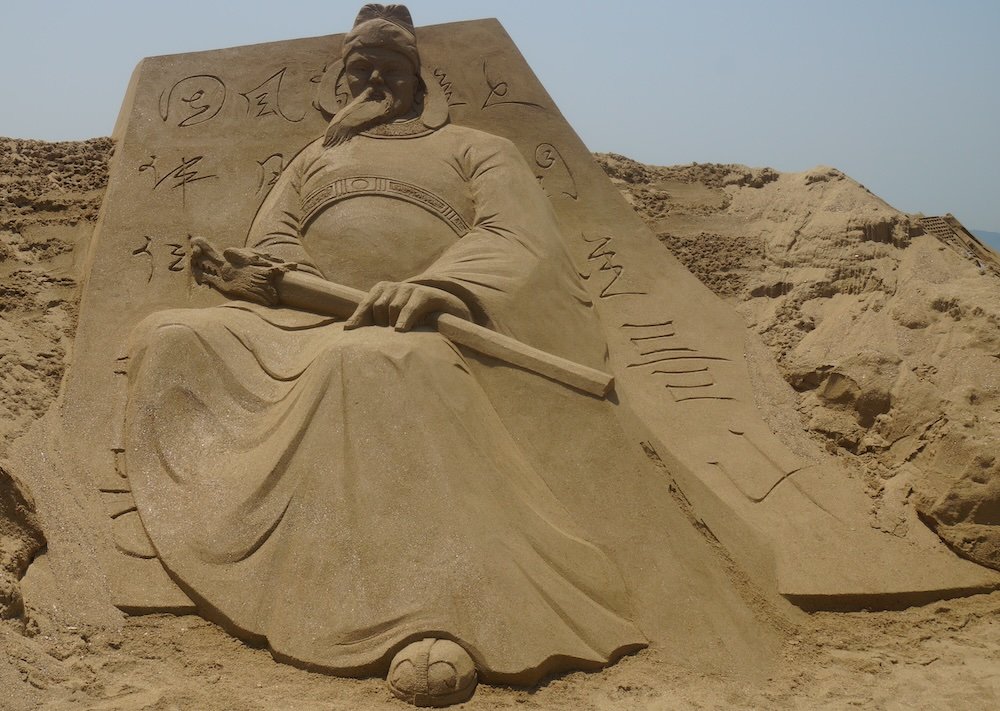
Sokcho Beach (Gangwon-do)
On Korea’s northeastern coast, Sokcho Beach offers a peaceful escape with its crystal-clear waters and fine white sand. Located near Seoraksan National Park, it’s ideal for combining a beach day with hiking or exploring Sokcho’s famous seafood markets. The beach is relatively uncrowded compared to Busan’s beaches, making it perfect for a quieter seaside getaway.
- Mountain Views: What sets Sokcho Beach apart is the stunning view of nearby Seoraksan Mountain. This beach provides a unique mix of coastal beauty and mountainous backdrop, creating a serene and picturesque experience.
Hyeopjae Beach (Jeju Island)
Hyeopjae Beach on Jeju Island is known for its clear blue waters, shallow depths, and fine white sand mixed with crushed seashells. Located near Hallim Park, it’s perfect for families due to its calm waters and scenic surroundings. The beach’s stunning views of Biyangdo Island make it a must-visit for photographers and nature lovers alike.
- Why It Stands Out: Jeju Island’s volcanic landscapes paired with Hyeopjae Beach’s tranquil waters make it one of South Korea’s most beautiful coastal destinations. Plus, the nearby Hallim Park adds a touch of nature and exploration to your beach day.
Jungmun Saekdal Beach (Jeju Island)
Also located on Jeju Island, Jungmun Saekdal Beach is known for its multicolored sands, ranging from white to black, red, and gray. It’s a hotspot for surfers due to its strong waves, making it the go-to beach for adventure seekers. Nearby, you can explore the Jusangjeolli Cliffs, a stunning rock formation created by volcanic activity.
- Adventure and Beauty: With its unique sand colors and opportunities for surfing, Jungmun Beach offers a more adventurous experience. It’s the perfect spot for those who want to combine natural beauty with thrilling watersports.
Naksan Beach (Yangyang)
Naksan Beach, located in Yangyang County, is another pristine spot for beach lovers. Famous for its clear waters and golden sand, it’s popular among families and surfers alike. The nearby Naksansa Temple, perched on a cliff overlooking the sea, adds a cultural touch to your visit. This beach is also known for its stunning sunrises.
- Cultural and Scenic Appeal: Naksan Beach offers a unique mix of natural beauty and cultural significance, with the ancient Naksansa Temple providing breathtaking views and a peaceful retreat.
Eurwangni Beach (Incheon)
Eurwangni Beach is a perfect spot for those flying in or out of Incheon Airport, as it’s only a short drive away. The beach is known for its soft sand and calm, shallow waters, ideal for swimming and water activities. Eurwangni’s laid-back atmosphere and proximity to Seoul make it a popular weekend getaway for locals.
- Convenience and Charm: Its proximity to the airport makes Eurwangni Beach a convenient stop for travelers looking to enjoy the sea before or after a flight. Plus, the sunsets here are stunning, offering a peaceful close to your day.


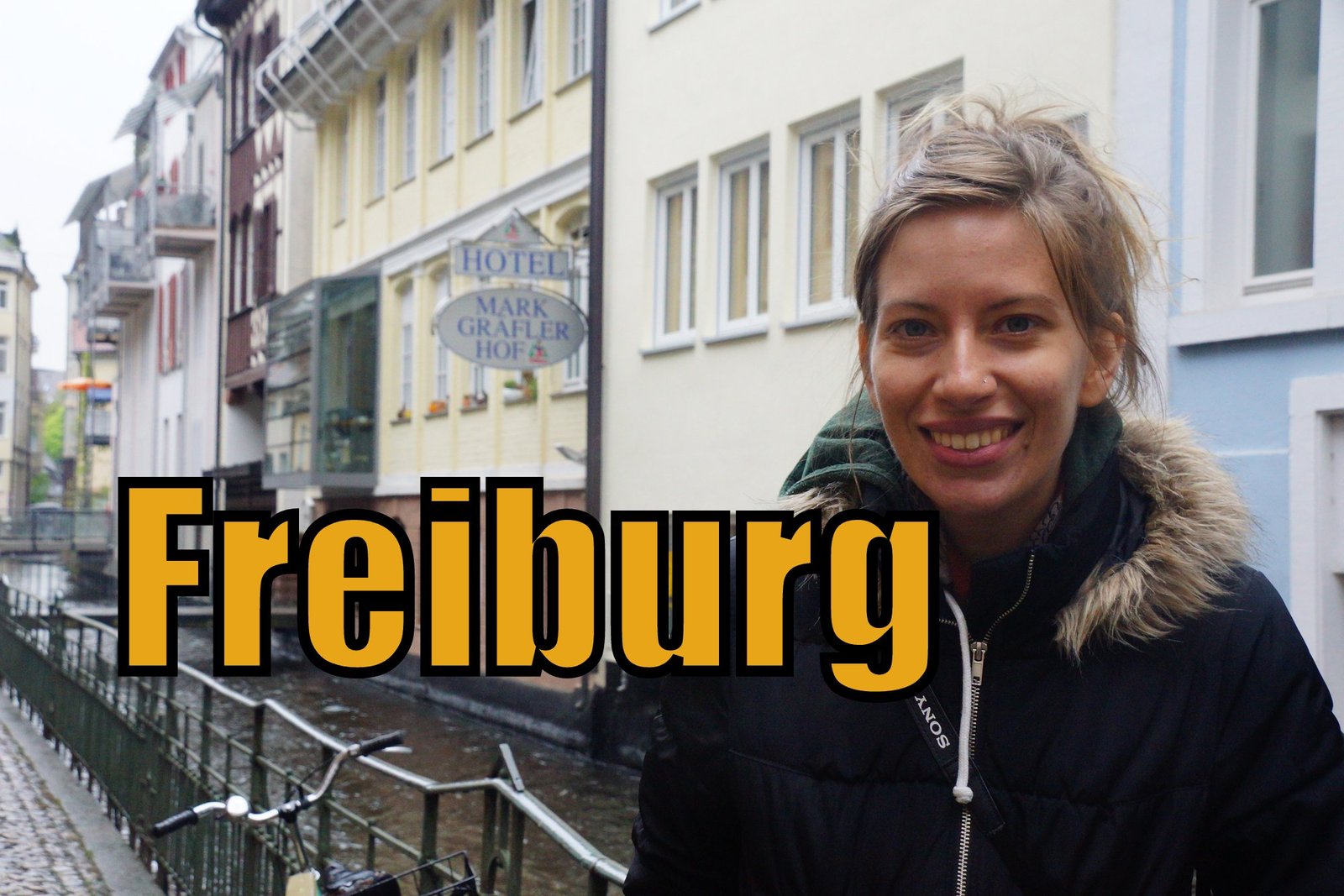
Images captured by you are really eyecatching. Your experience and these images are a perfect combo.
Nice view of Nature!!! I love south Korea specially their movies…. and dramas.. 🙂 🙂
Nice! Very inspiring and I have no doubt to take a trip to Daecheon soon..
Many of my friends are Korean and South Korea is a destination I always have wanted to explore, thanks for the heads up. No doubt when I am there, will drink some Soju on the beach!
Hi there! Great article and also an interesting beach! I too lived in South Korea for about a year and half and taught English there. Wow do I remember the humidity!
Currently I’m living in Brazil which is very humid but nothing compared to what I experienced in Korea. –Walking down the street completely soaked in sweat and miserable.
A trip to the beach is the perfect escape. We took a few beach weekends while living there. The beach culture is so different from what I’m used to, and I was amazed that so many South Korean’s do not know how to swim! They live on a penninsula, yet the majority of people don’t swim. I’m a water lover so it baffles me.
Thanks for the great article, and for making me nostalgic of my days teaching English in South Korea!
Cheers!
Elizabeth
It’s quite clear that nobody who has been to S.Korea complains about the internet speed as the statistics show they’ve got the fastest in the world. Regarding the humidity, I didn’t know they’re on this latitude for high humidity! Thanks for informing us. It’s always good to know before you travel there. I hate such weather particularly in summer.
Indeed, the internet speeds are amazing. Downloads and uploads and HD streaming are a joy. The best time to visit Korea is in the spring or fall.
Daecheon Beach has a well fame as far I know & backpackers often like to enjoy in the beach. The way I welcoming all tourists enjoying this one & probably it’ll be a memorable spot too.
Thanks again!
Daecheon is an interesting place, but I still prefer the Busan beaches. I went to a side beach really close to Daecheon and there was a really weird model shoot, with a bunch of 20-30 old Korean men taking photos of topless Korean girls. It was pretty weird.
Daecheon is a little empty for my taste, but worth a visit I guess.
Great post really! The rice fields were very fascinating that emphasized symbol of youth. What types of drinks they sold? Cocktails or Mocktails? Moreover, above all information and images were so informative & beautiful too.
Thanks James Shannon! I wish you’ll continuing your writing & sharing.
Best regards,
Saiful
I just returned from Vietnam where we spent several hours in the Incheon airport each way awaiting our connecting flights. Unfortunately, the airport was the only taste of Korea I got. ‘Next time I’ll be sure to book a long enough layover to get out and explore a little. Maybe even go to the beach!
Busan and vicinity is also a great place to go the beach in Korea (for those seeking the best urban beach experiences in Korea), but Daecheon rules for not being so crowded as the ones in the south!
Definitely is important to know where the beach is especially when it gets so humid.
Definitely man … Korea is the worst for humidity in the summer time … same latitude as the American South, heat index close to the 40’s in Celsius (in the 100’s in Fahrenheit). A trip to the beach fixes that!